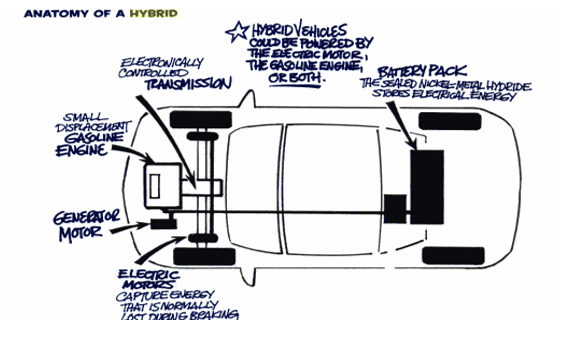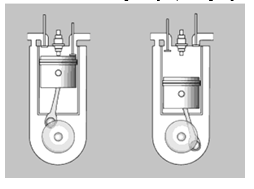This is a Report we want to provide our friends in the industry who require hybrid engines. As requested, we are providing you a description of how a hybrid engine for vehicles works that may be beneficial to your business and daily needs.
New models of the hybrid engine are in the market as introduced by various car manufacturers. How hybrid works fascinates car makers and enthusiasts as well.
Ford has fitted a hybrid engine in Escape and four more models will hit the market in the next few years. Likewise, General Motors (GM) and Daimler Chrysler are also working together to develop an even more efficient technology. They have one now to be introduced to the market. BMW is also in on this collaborative venture. Audi is working flat out on a hybrid engine for its new Q7 SUV, and even Porsche is considering the option of a hybrid solution for its Cayenne SUV. (Gottschalk and Kalmbach 125)
Why hybrid?
Before this hybrid engine is started, there was concept development and research into alternative technologies. There is a clear direction for the program and technology to build the hybrid engine.
A hybrid engine works differently from an ordinary engine. The hybrid system is the car industry’s answer to the environmental problem – climate change and global warming due to excessive coal gas emissions and the use of fossil fuel of industries.
Hybrid means a mix, amalgam, or crossbreed of two different things. Hybrid engines mate two different power technologies into an integrated powerplant. This means hybrids incorporate a high-efficiency gasoline engine and some type of electric drive to boost performance and reduce dependence on the gasoline engine. A sophisticated electronic controller is used to determine which of three options will power the vehicle:
- the gasoline or diesel engine
- the batteries
- both the engine and batteries
The electronic system or controller does the trick.
A hybrid has an engine that runs on oil, and can also shift into the battery. There are numerous problems in building this hybrid car because usually, the problem lies in the battery. The battery driving the motor portion of the hybrid is a continual problem. A key requirement is to make the battery as small as possible so that the car would not be viewed as a “battery carrier,” yet still have the power needed to meet the target of doubling the fuel efficiency of the car.
In short, the battery has to be made smaller, about one-tenth the size of an electric vehicle battery. The problem here is that the battery is very sensitive to heat conditions and would shut down on hot days. Likewise, it also shuts down if the weather is too cold.
A key part of the solution is to put the battery in the trunk, which is the most protected from heat and the easiest to keep cool.
This hybrid system can have a fuel economy consumption of 48 mpg to 55 mpg. Featured in our hybrid system is a small 1-liter gas engine supplemented by an 8-horsepower electric motor mounted between the engine and manual transmission. The vehicle starts on gas power, then adds the electric boost when needed.
A sophisticated battery pack operates the electric motor and recharges while driving. Toyota’s Prius is similar but very different. The Prius utilizes an electric motor to get the vehicle underway, then brings the small gas engine online at roughly eight miles per hour. Recently, several carmakers have introduced sophisticated four-wheel-drive hybrid systems on light trucks and SUVs.
The obvious benefit of hybrid drives is efficiency – lower consumption of fossil fuels.
There are more manufacturers now into hybrid manufacturing because of the many benefits of hybrid cars. More hybrid drive systems are currently in development and headed toward the market as consumers, industry, and government’s focus on alternative fuels and power sources intensifies.

How does a hybrid work?
The types of hybrid are described in how it works. A hybrid is composed of a gasoline engine and an electric motor which both have one purpose – to move the car. When the two works independently to move the car, it is called a parallel hybrid. The two also may work at the same time or may work alternately, to keep the car moving.
A series hybrid is somewhat complicated and works differently. The engine (gas or diesel) is not directly connected to the transmission; instead, it powers a generator that charges the batteries. The batteries power the electric motor which is connected to the transmission. The series hybrid is controlled by a computer monitoring system. (Walker)
“The basic idea is to let the gas engine do what it does well and the battery-driven motor does what it does well, thus recapturing as much as possible the energy generated during driving and braking” (Liker 56).
The gasoline engine has a small displacement. It allows for disabling individual cylinders during specific operational parameters, i.e. cruse speed where less power is needed. This can be accomplished electronically by disabling spark and fuel to specific cylinders with the benefit of increased fuel mileage.
The engine itself charges the battery while running, so that the acquiring and consumption of power becomes reciprocal, meaning it does not stop, or as soon as the engine keeps on running, it keeps on charging the battery. It also has a generator motor and electric motors and its transmission is electronically controlled.
The Austrian Hybrid
Another breakthrough in the hybrid is this one made by an Austrian firm that combines two-stroke crankcase induction with the four-cycle operation. The 4-Mix is the first production four-cycle engine that uses the piston to generate a supercharge effect by pressurizing the crankcase.
The crankcase permits the engine to be operated at any angle, which is an important feature for handheld tools.
This two-stroke engine has a supercharge effect, plus efficient four-stroke scavenging which produces 17 percent more torque than an equivalent two-stroke. It also has power is up 5 percent and a fuel economy of 30 percent, with a rotation speed of 10,000 rpm – the total loss oiling system, combined with Teutonic quality. (Dempsey 12)

As shown in the figure above, this Stihl 4-Mix combines two-stroke crankcase scavenging with a four-stroke operation. The right drawing shows the exhaust valve opens as the piston rises on the exhaust stroke. At the same time, air and fuel enter the crankcase. In the left-hand drawing, the piston has rounded TDC on the intake stroke. The falling piston pressurizes the crankcase, forcing the air-fuel mixture past the open intake valve and into the combustion chamber.
This is a different kind of hybrid engine in that it is different from the hybrid engine system. It is more sophisticated and if it is perfected and introduced in the market, car manufacturers will be surely huddling for the product to be incorporated into their cars.
Conclusion
Hybrid is the technology needed for the century to answer the growing demand for environmentally-friendly cars with low CO2 emissions. This technology minimizes environmental problems.
The goal of hybrid engines is far-reaching than short-term profitability. One benefit we can have is the opening of a mass market for more environmentally-friendly cars. Toyota, a leading car manufacturer, is now selling key components of the hybrid Prius to other manufacturers. It made fundamental innovations in its product development process that are being used for all vehicle development. By this measure, the returns on the project are priceless and the investment is almost trivial. In this 21st century, we can see more and more hybrid engines being invented and introduced to the market.
There is however a threat to the hybrid. There are more and more technologies being introduced by engineers and car manufacturers which can run a competition against the hybrid. One of these is the so-called ‘Blue Tec’ technology, which has a sophisticated exhaust gas treatment being perfected by Daimler Chrysler. This technology reduces nitrogen oxide emissions by as much as 80 percent, bringing them well below even California’s ultra-strict specifications. Blue-Tec technology depends on the availability of low-sulfur diesel fuels, and requires AdBlue, a urea solution, to be topped up at regular service intervals. This provides serious competition to our hybrid engine on two counts: fuel consumption and environment-friendly properties.
Works Cited
Brand, Paul. How to Repair Your Car. Minneapolis, MI: MBI Publishing Company, 2006.
Dempsey, Paul. Small Gas Engine Repair. United States of America: McGraw Hill Companies, 2008.
Gottschalk, Bern and Ralf Kalmbach. Mastering Automotive Challenges. United Kingdom: Kogan Page Ltd., 2007.
Liker, Jeffrey K. The Toyota Way: 14 Management Principles From The World’s Greatest Manufacturer. United States of America: McGraw Hill.
Walker, Michael. Hybrid Engines. 2003-2009. What price? Web.